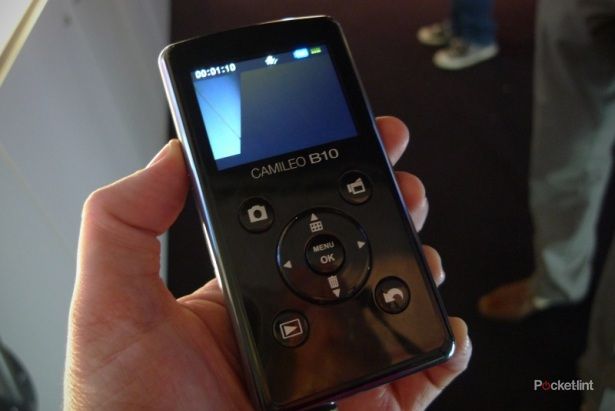Toshiba has expanded its Camileo linup of pocket camcorders with a new 'candybar' design, in the form of the B10. This compact camcorder is clearly designed to go head-to-head with models such as the Flip Video UltraHD and we managed to get some hands-on time with it at Toshiba's product showcase.
With its truly pocket-sized dimensions, the B10 is intended for casual shooting, and it certainly did look and feel very compact. While Toshiba's pistol grip design-toting models are smaller than full-size camcorders, they still need a fairly spacious pocket to accomodate them, while the B10 is only slightly bigger than a mobile phone measuring 18 x 56 x 108mm and weighing in at just 108g.
The fact that its designed for people who want to shoot quick vids is reflected in the fact that it includes the Camileo Upload button, so that you can upload your footage directly to YouTube and Facebook, among others. There's also a mini USB and a mini HDMI, should you want to hook the camcorder up to your computer or HDTV, but there's no handy flip-out arm as found on Flip's pocket cams.
The B10 has a 16x digital zoom and will take 16MP snaps with the on-board 5MP CMOS sensor, as well as recording up to 1080p. The card slot will take SD, SDHC and SDXC cards up to 64 GB, so you should get a fair few videos shot before you need to pop a new card in.
The front-facing button layout is pretty simple to get to grips with - there are controls for switching between still and video mode, as well as a playback button, a back button and a multi-directional control with an OK selector in the centre. In terms of features, the B10 also offers a 10s self-timer, face tracking, motion detection and video stabilisation to combat those shaky hands.
The 2-inch LCD screen is obviously a little on the small side, but then there isn't much room for it to be any bigger on a model of this size. Although it was hard to tell just how good the screen quality was in the dimly-lit product room, the screen looked better than those we've seen on some rival models. The B10 uses the same on-screen interface that's used on the P100, which looks similar to that seen on previous Camileo models. The onscreen interface is where some pocket camcorder models fall down, so it's good to see that the one on the B10 appears to be simple and logical to use, without the need to delve too deeply into the menu system.
The B10 will be available in May, and although no prices have been given, we would guess that it'll be somewhere around the £100 mark. We'll bring you a full review as soon as we can get our hands on one.

